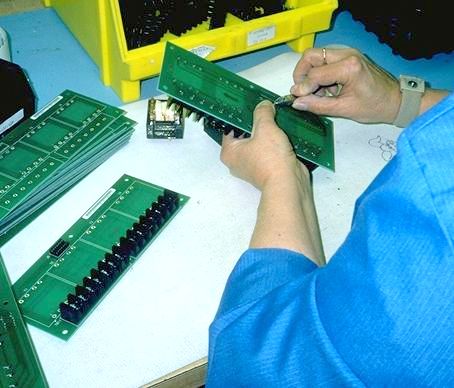 |
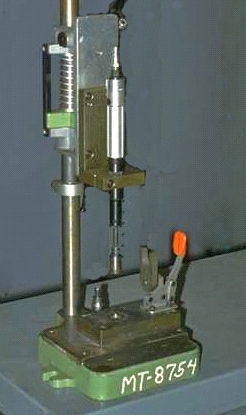 |
| Using the hand as a fixture — inefficient and hard on the wrist | Fixture for both the part and the tool |
Principles affected
Related pages
Workstations:
Machine Operation
Tools:
Background
A fixture is anything that secures an item, “fixing” it in place so that you don’t need to hold it. (See note on terminology below.) Usually, the fixture is the first piece of equipment to focus on in designing a workstation, once the ideal height and orientation are envisioned. Everything else in the workstation usually then revolves around the fixture.
The most common problems from lack of fixturing are:
- Using the hand as a fixture creates strain on the hand and wrist — often causing more risk for a musculoskeletal disorder than in the hand that does the work.
- One hand is eliminated from productive work — equivalent to working with one hand behind the back.
- Doubled exertion, since counteracting force is required, e.g., one arm against the other.
Common deficiencies in fixture design are:
- Inappropriate orientation of the item and fixture, that is, difficult to see or access what is needed.
- Inability to manipulate the item, creating long awkward reaches to access some portions.
Some of the most difficult items to fixture are those with short cycle times or small items that need to be quickly placed in different orientations. In these cases there may be no choice but to use the hand, but often fixturing is possible using the ideas listed below that enable quick loading and unloading.
Finally, some items are sufficiently heavy that they do not move when worked on. A fixture may not be needed.
Objectives
- Secure the object so that it does not move when work is being performed, i.e. achieve the principle of minimizing force.
- Orient the object to be in an optimal position for access, both physical and visual, i.e.clearance.
- Allow manipulation of the object to access all portions as needed, i.e, posture.
Ideas and Options
General concept
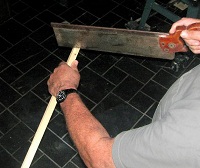 |
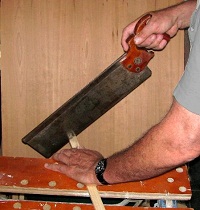 |
 |
| Difficult: Board in air | Better: Board on bench | Best: Board in vise |
The concept of fixturing is illustrated below with the common task of sawing a board with a hand saw. Sawing a board “in the air” is difficult (try it!) because of instability and having to exert the arms in opposite directions. Placing the board on a bench is better since it provides stability and eliminates exertion in one arm. Fixing the board in a bench vise secures it and enables efficient use of both hands on the saw.
Backstop
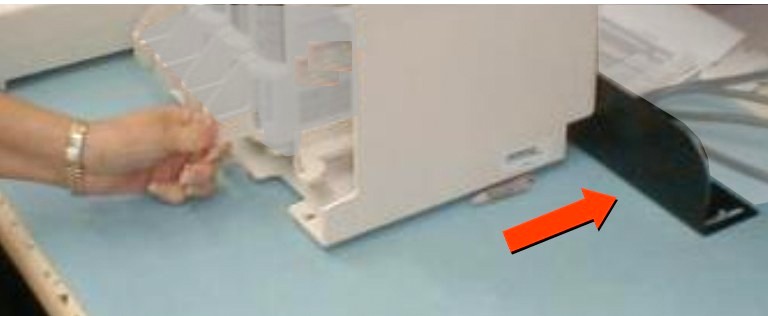 |
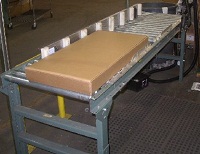 |
| Backstop on workbench (pushing forward to insert component) | Backstop on conveyor section (used for packing products) |
Probably the simplest type of fixture is a backstop, which can be as elementary as a heavy item placed behind an object to keep it from sliding forward when pushed against. Sections of angle iron are often used for this purpose. Backstops are usually homemade and very inexpensive, and can be very helpful despite the simplicity.
Also, in some ways, the work surface itself can be considered as a backstop, as with the example above of placing a board on a workbench to saw it.
Pins
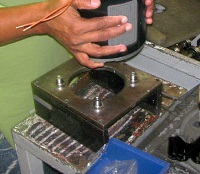 |
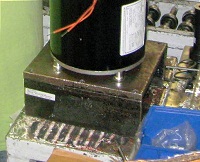 |
| Pins on fixture | Product in place, secured by pins |
Another very simple fixture is based on pins that are secured into a surface. The pins are located so that the edges or corners of the product fit against them, preventing the product from moving.
Cradles
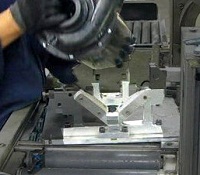 |
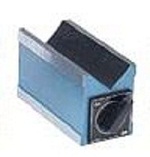 |
| Cradles provide stability without needing a clamp | V-block |
A cradle-style fixture is a configuration of a fixture that allows the product to nest in place, thus providing stability without needing a clamp. A V-block is a simple cradle, typically used for cylindrical objects. Mechanical clamps for V-blocks are available, as are electromagnetic V-blocks. Electromagnets are typically faster to use compared to clamps, since they can be activated more quickly and with less effort than clamps.
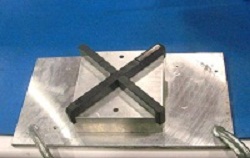 |
| Version of a cradle — the product placed on this fixture has X-shaped slots that fit precisely over the fixture. |
Quick release clamps
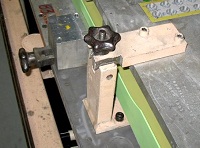 |
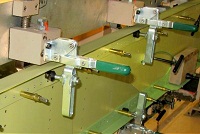 |
| Screw clamp — slow, hard on wrists | Quick release — generally faster and easier |
Clamps in general provide another inexpensive technique for fixturing objects. Any type of clamp can be useful in the right situation, but usually quick releases are best for repetitive use. Screw clamps are generally slow and create strain on the wrist, especially in higher volume production. Quick releases are usually better, since they are faster and easier to use. Many styles and capacities of quick releases are available, including heavy duty versions.
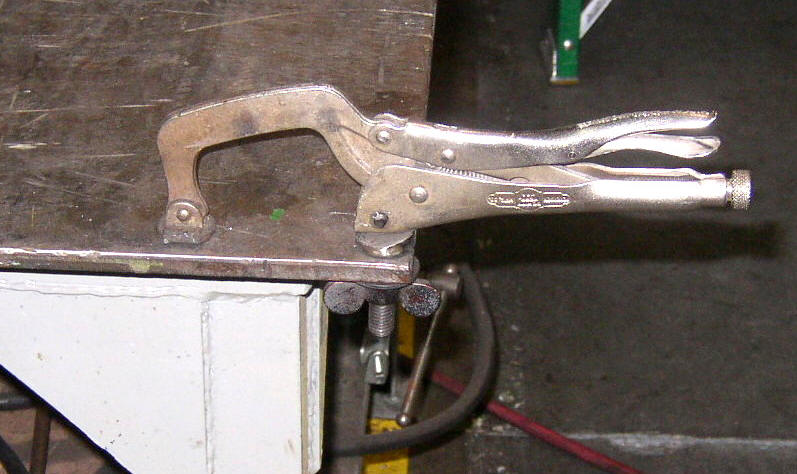 |
 |
| Bench clamp | Creative clamp |
Some items can be fixtured by simply clamping them to the bench, such as commonly done in welding operations above left. A C-clamp can be used, but for repetitive work, quick releases are better.
A very creative use of a manual clamp is shown above right. The hoses are integrated into the clamp and the clamp is integrated into the rest of the fixture.
There are countless styles of clamps that can be used for fixtures. Most of the above styles are available from standard industrial suppliers or can be searched on the internet as “quick release clamps” or simply “clamps.”
Classical bench fixture
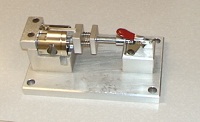 |
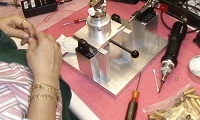 |
| Typical bench fixtures | |
There is no limit to the shape and features that can be incorporated, but typically the fixture must be fabricated for each item or task. Quick release levers are used in both fixtures above.
Common pitfall 1: The fixture is too light and slides around when working on it. It must be properly secured or heavy enough so that it does not move. Using the hand to hold the fixture defeats the purpose.
Common pitfall 2: The fixture does not place the item in an good orientation for working on it. Fixtures are easier to fabricate using right angles, but a tilted orientation is often better for work.
Powered clamps
 |
| Powered clamping system — one switch operates all clamps |
Powered clamps are often used in fixtures, particularly for large complicated fixtures. Two advantages are (1) no manual exertion is required, and (2) the clamps can be interconnected so that one switch operates multiple clamps. Powered clamps can create a safety hazard so may need guarding and/or two-hand controls.
Standard vise
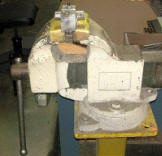 |
| Standard bench vise |
The most common type of universal fixture is the standard bench vise. The primary advantages of the vise are (1) the wide array of objects that can be secured with it, and (2) the ability to reposition objects in different orientations. The main disadvantage is that it is not well suited for volume production: (1) the screw action of the clamp takes time and arm motions to use, (2) the objects must normally be positioned with each use, which takes extra time and and can lead to inconsistencies in production, and (3) the one-size-fits-all design usually is not as effective as fixtures designed for a specific object.
Tilted and articulated fixtures
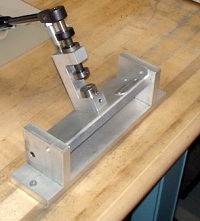 |
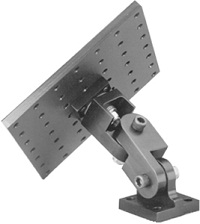 |
|
| Slanted fixture | Fixture plate on articulated arm | Articulated fixture |
A slant or articulation can often be easily incorporated into a fixture. The angle or orientation depends completely on the task and the shape of the object being worked on. The criteria for determining the orientation are based primarily on posture, visual access, and force requirements. However, other issues such as product flow or tool size and location can have an effect.
Tip: Some experimentation is often needed beforehand to determine the best orientation for a task. It can be helpful to arrange a mock fixture that can be changed in order to try various positions. Sometimes the mock fixture can be made from odds and ends that are available in the work area just to test different concepts. Alternatively, an adjustable base (such as the articulated arm in the above photo or a ball joint shown below) can be used for the test. It may take some time to determine the best orientation in order to overcome the feeling of awkwardness that is usually associated with doing a task a new way.
Ball joint
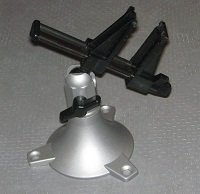 |
| Small vise mounted on ball joint |
The ball joint enables repositioning in various orientations in three dimensions. Some versions of this type of vise have vacuum suction bases that can be surprisingly solid. Available from industrial supply firms, hobby suppliers, work working stores, and retail outlets such as the large home improvement stores.
Common pitfall: The screw tightening mechanisms are usually not appropriate for rapid changes, since they can take extra time and can create strain on the wrists when done repetitively. Screw mechanisms are suitable for infrequent use, but quick releases or powered clamps are better for rapid changes.
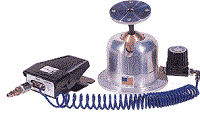 |
 |
| Heavy duty ball joint with air clamp (www.ergotechinc.com) | |
This heavy duty ball joint incorporates an air clamp operated with a foot pedal, which provides fast repositioning of the object so that it can be accessed from different angles.
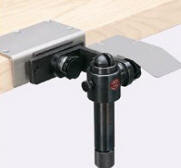 |
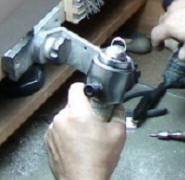 |
 |
| The Benchmate™ (www.grstools.com) provides excellent maneuverability for small items | ||
The Benchmate is a fixture used in the jewelry industry that may have application elsewhere. A hand grip is incorporated into the design that enables the object (a diamond ring in the photos above) to be instantaneously changed to almost any orientation. The design allows manipulation of the object almost as easily as if holding it in the fingers, but without the corresponding fatigue. The Benchmate is designed to be attached to the edge of a workbench, but can be adapted such as by mounting it on a post. (This device may be unique on the market, available through jewelry equipment suppliers.)
Rotating fixtures
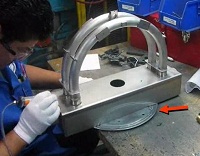 |
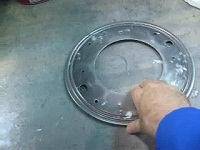 |
| Turntable in use (arrow) Click to see video clip |
Lightweight turntable (without product) |
Turntables (or “Lazy Susans”) provide a generally inexpensive way to turn objects on a horizontal plane. Several lightweight versions are available from industrial supply companies. They can also be easily fabricated.
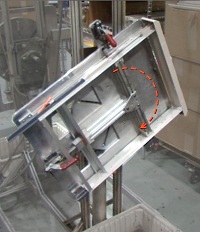 |
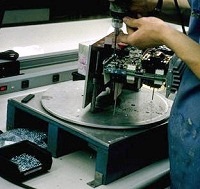 |
| Rotating fixture in vertical plane | Turntable incorporated into a larger fixture |
Fixtures can be designed to rotate objects on a vertical plane, in addition to the more standard horizontal orientation. Note that the fixture in the photo above left is a stand-alone device, not mounted on a workbench.
Additional
Terminology
In manufacturing, a “fixture” generally refers to a clamping device of some type. Depending on the application and industry, other terms such as “third hands,” “hold downs,” “work positioners,” and “jigs” can be used.
In the retail store environment, the term fixture has a broader connotation and includes holders such as shelves for groceries or racks for clothes. It is helpful to keep in mind this broader definition since it focuses on the underlying objective of “fixing” an object, rather than referring to a specific type of device.
More examples
The following are more examples of the countless types of fixtures that are available. The purpose is simply to provide ideas and stimulate creativity for developing highly effective fixtures.
What to look for
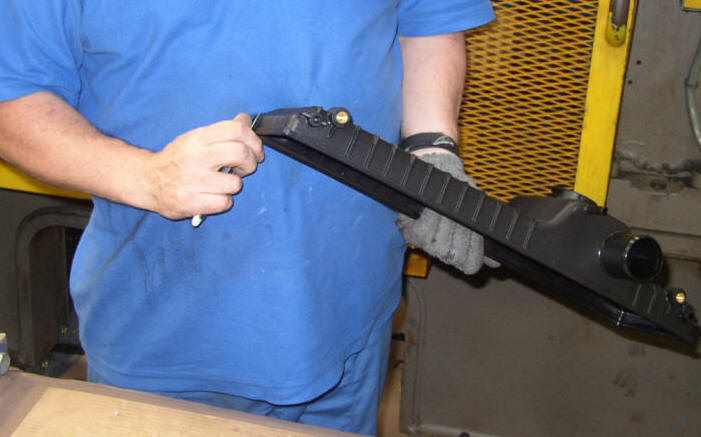 |
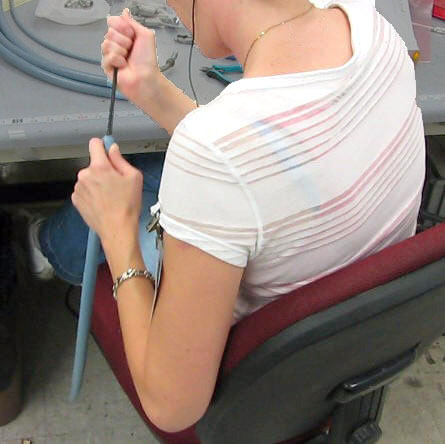 |
| “Working in the air” | |
Any time you see someone using the hand as a fixture should raise a red flag. But the worst scenario is “working in the air,” as shown in the photos above. There is no support for the hands and arms at all, and the work is generally much harder to do. Even if all you do is put the item on a workbench, it generally is easier.
However, there may be reasons why people don’t use the workbench. In the photo above left, it may be that the bench surface is too low, or that he needs to rotate the item quickly. Thus, it may be that a higher support surface is needed, perhaps with a turntable or some equivalent that provides good access to the edges.
In the photo above right, the long thin object doesn’t easily fit on the bench. It is not unheard of to cut a hole in the bench for this purpose, then perhaps add a clamp or whatever it needed for the task. There are many possible solutions, but the process starts by noticing people working in the air.
Take advantage of existing fixtures
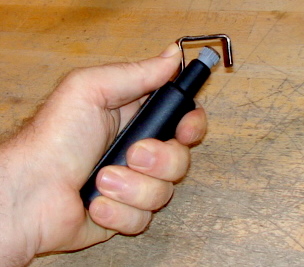 |
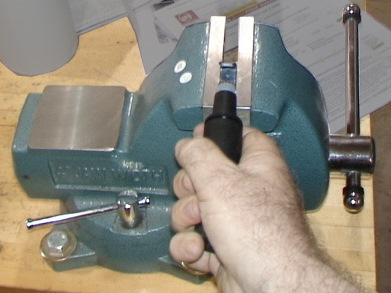 |
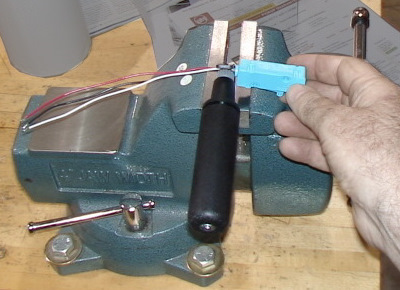 |
| Before: Wire stripper with thumb push | After: Place end in vise, pull with full hand | |
The example above shows a hand wire stripper that works by pushing the end piece with the thumb to open for placement of the wire. The end piece is spring-loaded, which is slow and tiring for the thumb when done repetitively.
A zero-cost solution was to use an adjacent vise. By fixing the end piece in the vise, the full hand can be used to pull the end piece open, taking advantage of much larger muscle groups.
Simple, removable
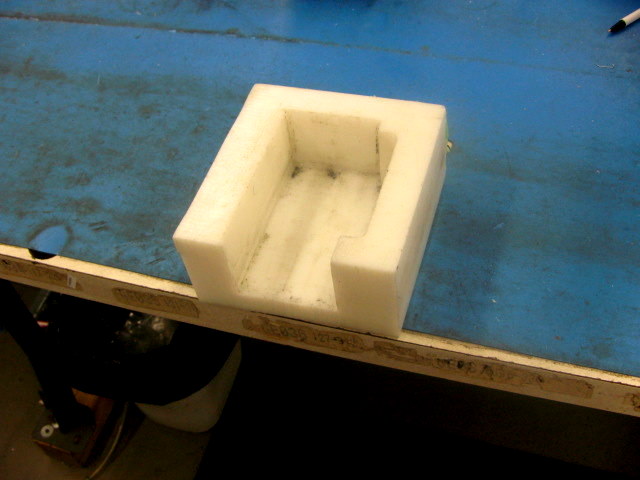 |
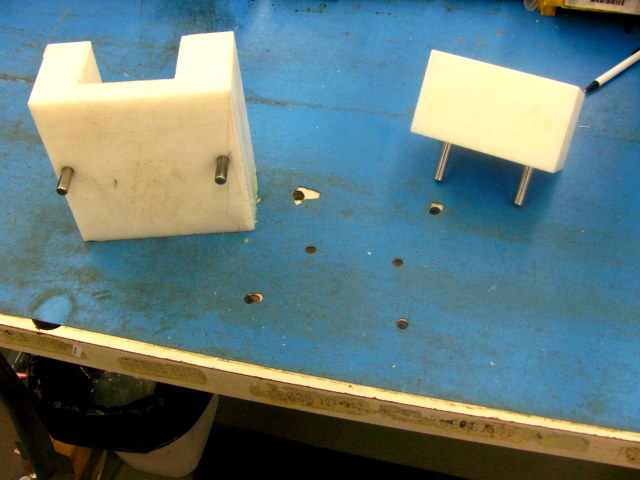 |
| Pegs fit into holes drilled into bench | |
These fixtures are simple, cut from polypropylene, and designed so that a clamp is not needed. They have pegs that fit into holes drilled into the workbench, so they’re easy to use and remove depending upon the product being built.
Jeweler’s block
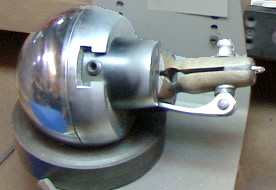 |
| Jeweler’s block (with adapted bicycle wheel clamp) |
A maneuverable fixture used in the jewelry industry is the engraving block. The block is essentially a heavy ball that rests in a concave support. The ball itself has jaws similar to a vise. In the photo above, an employee adapted a bicycle wheel quick release mechanism that is held in the block. Available from jewelry equipment suppliers, including GRS Tools.
Mounted, self-closing
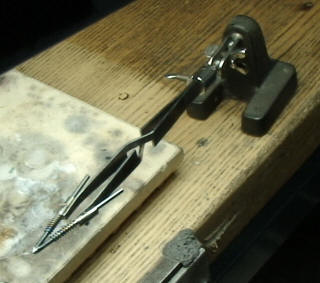 |
| Mounted, self-closing tweezers |
Adapted with special points See Tools: self-closing, mounted
